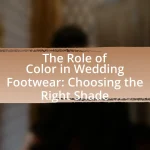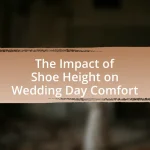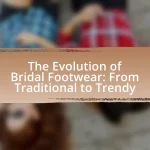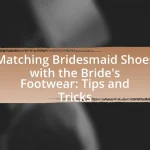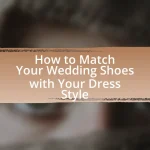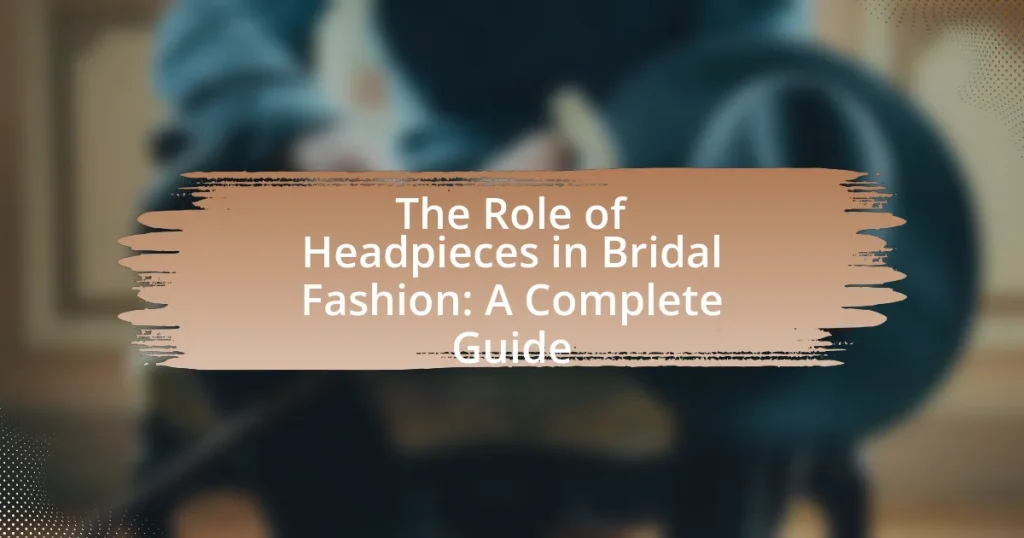The article focuses on the significance of headpieces in bridal fashion, highlighting their role as symbols of tradition, elegance, and personal expression. It explores the historical evolution of headpieces, detailing how they have transformed from simple floral crowns to elaborate designs influenced by cultural practices and royal customs. The article also examines various types of headpieces, including veils, tiaras, and hairpins, and discusses how contemporary trends, materials, and innovative techniques are shaping modern bridal accessories. Additionally, it provides practical tips for brides on selecting and coordinating headpieces with their hairstyles and wedding themes, ensuring comfort and aesthetic harmony.
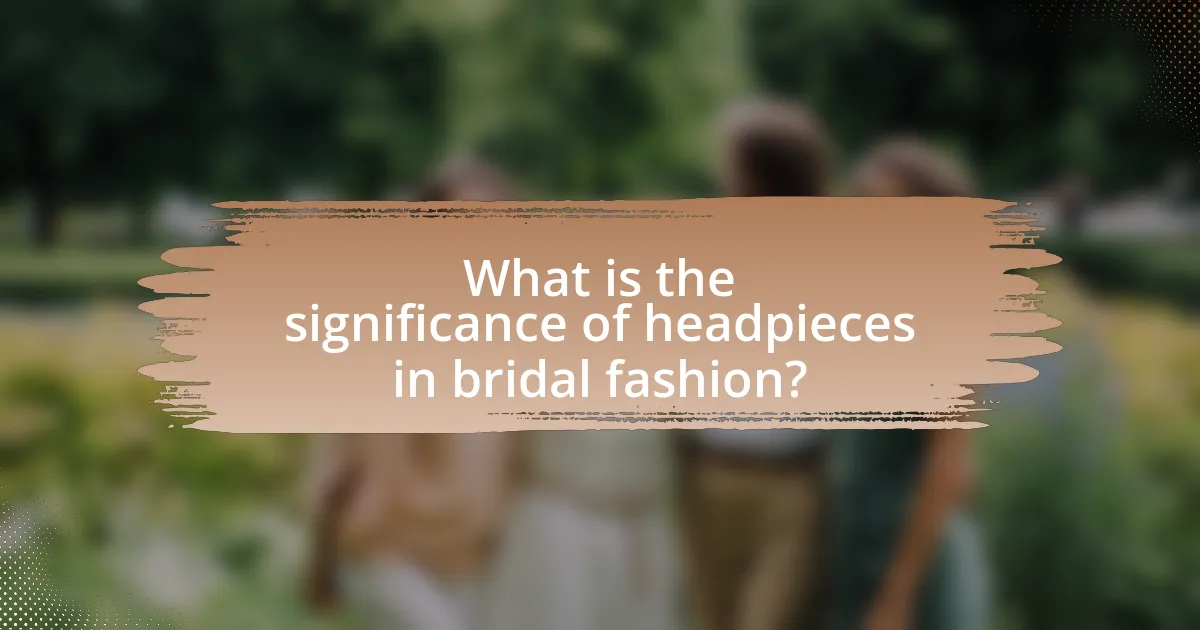
What is the significance of headpieces in bridal fashion?
Headpieces in bridal fashion are significant as they symbolize tradition, elegance, and personal expression. Historically, headpieces have been worn by brides to signify their status and to enhance their overall appearance on their wedding day. For example, in many cultures, veils represent modesty and purity, while tiaras and crowns can denote royalty and celebration. Additionally, headpieces allow brides to showcase their individual style, with options ranging from floral crowns to intricate hairpins, thus making a personal statement that complements their wedding attire. This dual role of headpieces as both a cultural symbol and a fashion accessory underscores their importance in bridal fashion.
How have headpieces evolved in bridal fashion over time?
Headpieces in bridal fashion have evolved significantly from ancient times to the present day. Historically, brides wore simple floral crowns or veils, symbolizing purity and fertility, as seen in ancient Roman and Greek traditions. During the Middle Ages, headpieces became more elaborate, with the introduction of ornate headdresses and veils that reflected social status, often adorned with jewels and intricate designs.
In the 19th century, Queen Victoria popularized the white wedding dress, which included a lace veil, influencing bridal fashion for generations. The 20th century saw a shift towards more diverse styles, with the introduction of birdcage veils and tiaras, reflecting changing societal norms and fashion trends.
Today, headpieces range from minimalist hairpins to elaborate crowns, showcasing individual style and cultural influences. This evolution illustrates how headpieces have transitioned from traditional symbols to modern expressions of personal identity in bridal fashion.
What historical influences have shaped modern bridal headpieces?
Modern bridal headpieces have been shaped by various historical influences, including ancient traditions, royal customs, and cultural practices. For instance, in ancient Rome, brides wore a wreath made of flowers and herbs, symbolizing fertility and prosperity, which laid the groundwork for floral designs in contemporary headpieces. Additionally, during the Victorian era, elaborate veils and tiaras became popular, influenced by Queen Victoria’s wedding to Prince Albert in 1840, which established the trend of wearing white and accessorizing with ornate headpieces. Furthermore, the 1920s flapper style introduced headbands adorned with feathers and jewels, reflecting the era’s fashion revolution. These historical elements have collectively contributed to the diverse styles of modern bridal headpieces, blending tradition with contemporary aesthetics.
How do cultural variations impact the design of bridal headpieces?
Cultural variations significantly influence the design of bridal headpieces by dictating materials, styles, and symbolic meanings associated with the headpieces. For instance, in Western cultures, bridal headpieces often include veils and tiaras, symbolizing purity and elegance, while in Indian culture, brides typically wear ornate maang tikka and dupattas, which represent tradition and cultural heritage. Additionally, the choice of colors and embellishments varies; for example, red is a predominant color in many Asian weddings, reflecting prosperity and happiness, whereas white is favored in Western weddings, symbolizing innocence. These cultural distinctions shape not only the aesthetic aspects of bridal headpieces but also their significance within the respective cultural contexts.
What are the different types of bridal headpieces available?
Bridal headpieces come in various types, including veils, tiaras, headbands, hairpins, and fascinators. Veils are traditional and can vary in length and style, often made from tulle or lace, symbolizing modesty. Tiaras are ornate, typically adorned with crystals or pearls, representing royalty and elegance. Headbands can be simple or embellished, providing a modern touch to bridal attire. Hairpins are versatile accessories that can be used to secure hairstyles while adding decorative elements. Fascinators are stylish, often featuring feathers or flowers, and are popular for a more contemporary look. Each type serves to enhance the bride’s overall appearance and complement her wedding theme.
What are the characteristics of veils as bridal headpieces?
Veils as bridal headpieces are characterized by their length, material, and decorative elements. Typically made from lightweight fabrics such as tulle, lace, or organza, veils can vary in length from short birdcage styles to long cathedral lengths, allowing for versatility in bridal aesthetics. Additionally, veils often feature embellishments like beading, embroidery, or lace trim, enhancing their visual appeal and complementing the overall bridal gown. Historically, veils symbolize modesty and purity, adding a traditional element to modern weddings.
How do tiaras differ from other headpiece styles?
Tiaras differ from other headpiece styles primarily in their design and cultural significance. Unlike simpler headpieces such as veils or hairpins, tiaras are typically ornate, often featuring intricate designs with gemstones or pearls, and are worn as a symbol of royalty or status. Historically, tiaras have been associated with formal occasions and are often seen in royal ceremonies, distinguishing them from other headpieces that may serve more practical or casual purposes. For example, while a veil may symbolize modesty in bridal fashion, a tiara represents elegance and grandeur, making it a favored choice for brides seeking a regal appearance on their wedding day.
What role do hairpins and combs play in bridal hairstyles?
Hairpins and combs serve crucial roles in bridal hairstyles by providing both functionality and aesthetic enhancement. Hairpins secure intricate styles, ensuring that the hair remains in place throughout the ceremony and reception, while combs can add decorative elements, contributing to the overall bridal look. Historically, hairpins have been used since ancient times, with evidence of their use in various cultures, highlighting their importance in maintaining hairstyles. Combs, often adorned with jewels or floral designs, not only assist in styling but also elevate the elegance of the bridal ensemble, making them essential accessories in modern bridal fashion.
Why are headpieces considered essential for brides?
Headpieces are considered essential for brides because they enhance the overall bridal look and symbolize tradition and elegance. Historically, headpieces have been worn by brides across various cultures, signifying purity and celebration. For instance, in Western traditions, veils and tiaras are common, often representing the transition from maidenhood to marriage. Additionally, headpieces can complement the wedding dress and hairstyle, creating a cohesive aesthetic that is visually striking in photographs. This importance is reflected in the fact that many bridal designers incorporate headpieces into their collections, emphasizing their role in modern bridal fashion.
How do headpieces enhance the overall bridal look?
Headpieces enhance the overall bridal look by adding elegance and a focal point to the hairstyle. They can complement the wedding dress, reflect the bride’s personal style, and elevate the overall aesthetic of the bridal ensemble. For instance, a veil can create a romantic and traditional appearance, while a floral crown may evoke a bohemian vibe. According to a study published in the Journal of Fashion Marketing and Management, accessories like headpieces significantly influence perceptions of beauty and style, demonstrating their impact on the overall bridal presentation.
What emotional significance do headpieces hold for brides?
Headpieces hold significant emotional value for brides as they symbolize personal expression and cultural heritage. These adornments often represent a bride’s individuality, allowing her to convey her unique style on a momentous occasion. Additionally, headpieces can carry sentimental meaning, such as being family heirlooms or gifts from loved ones, which enhances their emotional significance. Historical context shows that headpieces have been used in various cultures to signify marital status and social standing, further deepening their importance in bridal fashion.
How do you choose the right headpiece for your wedding?
To choose the right headpiece for your wedding, consider your dress style, hair type, and overall wedding theme. The headpiece should complement the gown’s design; for instance, a vintage dress pairs well with a classic tiara, while a bohemian gown suits floral crowns. Additionally, your hair type influences the choice; for long hair, a comb or hairpins may work best, while short hair might benefit from a headband. Finally, align the headpiece with your wedding theme; a beach wedding may call for a simpler, more natural look, whereas a formal event allows for more elaborate designs.
What factors should be considered when selecting a headpiece?
When selecting a headpiece, factors such as style, comfort, hair type, and the overall theme of the event should be considered. The style of the headpiece should complement the bridal gown and the wedding theme, ensuring a cohesive look. Comfort is crucial, as the headpiece will be worn for an extended period; it should fit securely without causing discomfort. Hair type influences the choice of headpiece, as certain designs work better with specific hairstyles, such as updos or loose waves. Additionally, the overall theme of the wedding, whether it is vintage, modern, or bohemian, should guide the selection to enhance the bridal aesthetic effectively.
How can the style of the wedding dress influence headpiece choice?
The style of the wedding dress significantly influences the choice of headpiece by determining the overall aesthetic and formality of the bridal look. For instance, a classic ball gown often pairs well with a tiara or a formal veil, enhancing the traditional elegance of the dress. Conversely, a bohemian-style dress may be complemented by floral crowns or simpler headbands, aligning with its relaxed vibe. This correlation is supported by bridal fashion trends, which show that headpieces are typically selected to harmonize with the dress’s silhouette, fabric, and embellishments, ensuring a cohesive appearance.
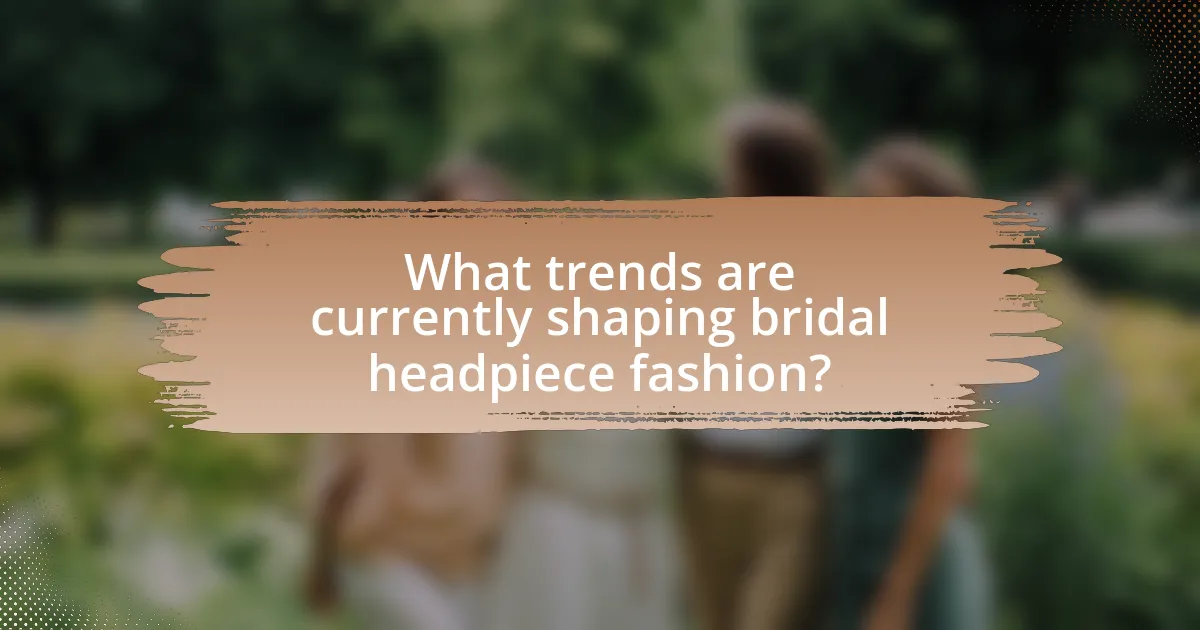
What trends are currently shaping bridal headpiece fashion?
Current trends shaping bridal headpiece fashion include the rise of minimalist designs, the use of natural materials, and the popularity of personalized pieces. Minimalist headpieces, characterized by clean lines and understated elegance, are favored for their versatility and modern appeal. Natural materials such as flowers, leaves, and organic fabrics are increasingly incorporated, reflecting a shift towards eco-conscious choices in bridal fashion. Additionally, personalized headpieces that incorporate unique elements, such as initials or family heirlooms, are gaining traction as brides seek to express their individuality. These trends are supported by industry reports indicating a growing preference for sustainable and customized wedding accessories among modern brides.
How are modern materials impacting headpiece design?
Modern materials are significantly enhancing headpiece design by allowing for greater creativity, durability, and comfort. Innovations such as lightweight plastics, advanced textiles, and 3D printing technology enable designers to create intricate and unique shapes that were previously difficult to achieve. For instance, the use of breathable fabrics and flexible materials ensures that headpieces can be worn comfortably for extended periods, which is particularly important for bridal wear. Additionally, materials like acrylic and resin provide a modern aesthetic while maintaining structural integrity, allowing for elaborate designs that can incorporate elements like LED lighting or intricate embellishments. These advancements not only improve the visual appeal of headpieces but also cater to the practical needs of modern brides.
What innovative techniques are being used in headpiece creation?
Innovative techniques in headpiece creation include 3D printing, laser cutting, and the use of smart textiles. 3D printing allows for intricate designs that are lightweight and customizable, enabling designers to create unique shapes and structures that traditional methods cannot achieve. Laser cutting provides precision in fabric manipulation, allowing for detailed patterns and designs that enhance the aesthetic appeal of headpieces. Smart textiles incorporate technology, such as LED lights or sensors, which can change colors or respond to environmental stimuli, adding an interactive element to headpieces. These techniques reflect advancements in technology and design, pushing the boundaries of traditional bridal fashion.
How do contemporary designers approach traditional headpiece styles?
Contemporary designers reinterpret traditional headpiece styles by blending modern aesthetics with cultural significance. They often incorporate innovative materials and techniques, such as 3D printing and sustainable fabrics, to create unique pieces that resonate with contemporary bridal fashion trends. For instance, designers like Vera Wang and Marchesa have successfully merged classic elements, such as lace and floral motifs, with minimalist designs, appealing to modern brides who seek both elegance and individuality. This approach not only honors the heritage of traditional headpieces but also adapts them to current fashion sensibilities, ensuring their relevance in today’s bridal market.
What are the most popular headpiece styles for brides today?
The most popular headpiece styles for brides today include veils, tiaras, headbands, and floral crowns. Veils remain a classic choice, often ranging from short birdcage styles to long cathedral lengths, providing a traditional and elegant look. Tiaras, often adorned with crystals or pearls, add a regal touch and are frequently chosen for formal weddings. Headbands, which can be embellished with beads or lace, offer a modern and versatile option that complements various hairstyles. Floral crowns, made from fresh or artificial flowers, have gained popularity for their bohemian aesthetic, appealing to brides seeking a natural and whimsical vibe. These styles reflect current bridal trends, emphasizing personalization and the blending of traditional and contemporary elements in wedding fashion.
Which headpiece styles are trending in 2023?
In 2023, trending headpiece styles include oversized floral crowns, minimalist veils, and statement hairpins. Oversized floral crowns have gained popularity for their romantic and bohemian aesthetic, often featuring a mix of fresh and dried flowers. Minimalist veils, characterized by their simplicity and elegance, are favored for their versatility and ability to complement various bridal styles. Statement hairpins, often adorned with crystals or pearls, are being used to add a touch of glamour and individuality to bridal hairstyles. These trends reflect a shift towards personalization and unique expressions in bridal fashion.
How do celebrity weddings influence bridal headpiece trends?
Celebrity weddings significantly influence bridal headpiece trends by setting style standards that many brides aspire to emulate. High-profile weddings often showcase unique and extravagant headpieces, which are widely publicized through media coverage and social platforms, leading to increased demand for similar styles among brides. For instance, when celebrities like Meghan Markle and Kate Middleton wore distinctive tiaras, it sparked a resurgence in interest for similar pieces, as evidenced by a 2019 survey from The Knot, which indicated that 30% of brides sought to replicate celebrity wedding styles. This trend demonstrates how celebrity choices can shape market offerings and consumer preferences in bridal fashion.
What practical tips can brides follow when wearing headpieces?
Brides should ensure their headpieces are securely attached to avoid any slips during the ceremony. Using bobby pins or combs can provide additional stability, especially for heavier pieces. It’s also important for brides to choose headpieces that complement their hairstyle; for instance, a veil may work better with an updo, while floral crowns suit loose waves. Additionally, brides should consider the weight and comfort of the headpiece, as wearing it for an extended period can cause discomfort. Finally, coordinating the headpiece with the overall wedding theme and dress style enhances the visual harmony of the bridal look.
How can brides ensure comfort while wearing headpieces throughout the day?
Brides can ensure comfort while wearing headpieces throughout the day by selecting lightweight materials and securing the headpiece properly. Lightweight materials, such as fabric flowers or lace, reduce pressure on the scalp, while proper securing techniques, like using bobby pins or combs, prevent shifting and discomfort. Studies indicate that discomfort often arises from heavy or poorly fitted accessories, emphasizing the importance of choosing the right design and fit for prolonged wear.
What maintenance tips should brides consider for their headpieces?
Brides should regularly clean and store their headpieces properly to maintain their condition. Cleaning involves gently wiping the headpiece with a soft, dry cloth to remove dust and oils, while avoiding moisture that could damage delicate materials. Proper storage requires placing the headpiece in a protective box or bag, away from direct sunlight and humidity, to prevent fading and warping. Additionally, brides should avoid wearing their headpieces in environments where they may be exposed to excessive heat or moisture, as these factors can compromise the integrity of the materials used.
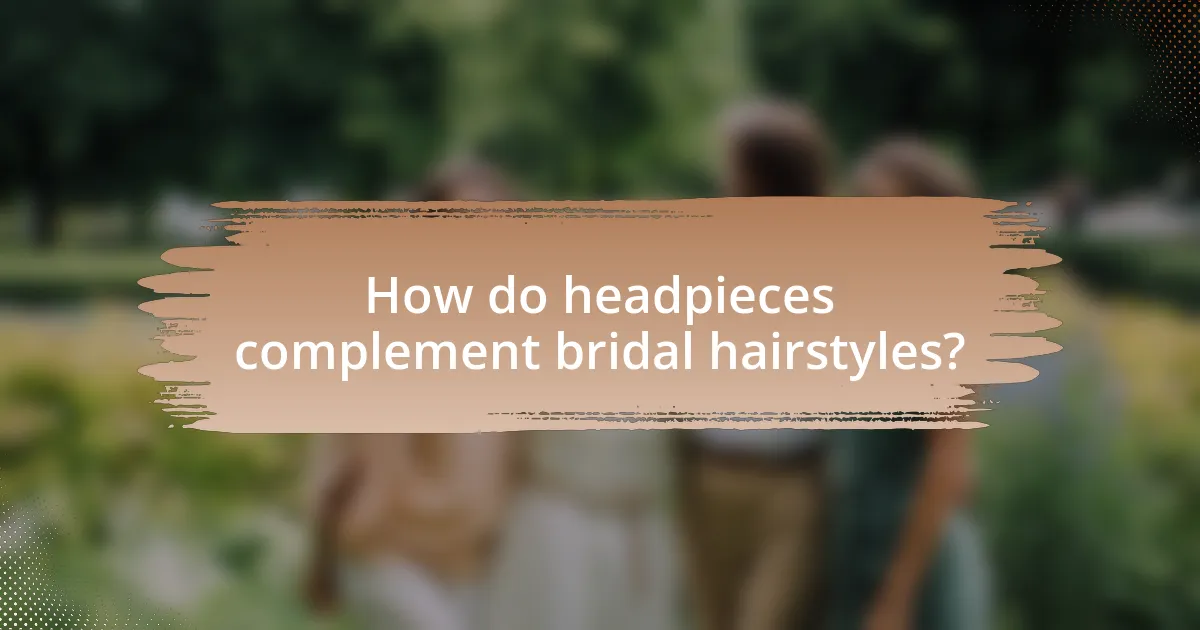
How do headpieces complement bridal hairstyles?
Headpieces enhance bridal hairstyles by adding elegance and visual interest, creating a cohesive look that aligns with the overall wedding theme. They serve as focal points that draw attention to the bride’s face and hairstyle, often incorporating elements like lace, pearls, or floral designs that harmonize with the dress and accessories. For instance, a veil can soften a sleek updo, while a tiara can elevate a romantic, loose hairstyle. Studies in fashion design emphasize that accessories like headpieces can significantly influence the perception of a bridal look, making it more memorable and distinctive.
What hairstyles work best with different types of headpieces?
Different hairstyles complement various types of headpieces effectively. For instance, updos, such as chignons or sleek buns, work well with tiaras and crowns, as they provide a clean backdrop that highlights the headpiece. Loose waves or soft curls pair beautifully with floral crowns and headbands, creating a romantic and bohemian look. Half-up, half-down styles are versatile and can suit both veils and decorative combs, balancing elegance with a relaxed vibe. Additionally, sleek ponytails can enhance modern headpieces like geometric clips or minimalist bands, offering a chic and polished appearance. These combinations are widely recognized in bridal fashion, ensuring that the chosen hairstyle enhances the overall aesthetic of the headpiece.
How can brides coordinate their headpiece with their chosen hairstyle?
Brides can coordinate their headpiece with their chosen hairstyle by selecting designs that complement the hair’s texture, length, and style. For instance, if a bride opts for an updo, a smaller, more delicate headpiece like a comb or a tiara can enhance the elegance without overwhelming the look. Conversely, for loose waves or long hair, a larger floral crown or a statement headband can create a balanced appearance. Additionally, considering the color and material of the headpiece in relation to the hair color and overall wedding theme ensures a cohesive aesthetic. This approach is supported by bridal stylists who emphasize the importance of harmony between hair and accessories for a polished bridal look.
What are some popular hairstyle trends that pair well with headpieces?
Popular hairstyle trends that pair well with headpieces include loose waves, sleek updos, and braided styles. Loose waves create a romantic look that complements floral crowns and tiaras, while sleek updos provide a sophisticated backdrop for statement pieces like veils and combs. Braided styles, such as fishtail or crown braids, offer a bohemian vibe that works beautifully with various headpieces. These trends are favored in bridal fashion for their versatility and ability to enhance the overall aesthetic of the look.
How can brides personalize their headpieces?
Brides can personalize their headpieces by selecting unique materials, incorporating personal symbols, and customizing designs to reflect their individual style. For instance, brides may choose fabrics like lace or silk that resonate with their wedding theme, or add elements such as family heirlooms or charms that hold sentimental value. Customization options also include altering the shape, size, or embellishments of the headpiece, allowing brides to create a distinctive look that aligns with their personality and wedding aesthetic. This approach not only enhances the headpiece’s significance but also ensures it complements the overall bridal ensemble.
What customization options are available for bridal headpieces?
Bridal headpieces offer a variety of customization options, including materials, embellishments, styles, and sizes. Brides can choose from materials such as lace, silk, or tulle, and embellishments like pearls, crystals, or flowers to create a unique look. Additionally, styles can range from tiaras and combs to veils and hairpins, allowing for personalization that complements the overall wedding theme. Custom sizes ensure a perfect fit, enhancing comfort and appearance. These options enable brides to tailor their headpieces to reflect their individual style and wedding aesthetics.
How can personal style be reflected in headpiece choices?
Personal style can be reflected in headpiece choices through the selection of materials, designs, and colors that resonate with an individual’s aesthetic preferences. For instance, a bride who favors vintage fashion may opt for a lace or beaded headpiece, while a modern bride might choose a sleek metallic or minimalist design. Additionally, personal style is often expressed through the incorporation of unique elements, such as floral accents for a bohemian look or geometric shapes for a contemporary vibe. This alignment of headpiece choices with personal style is supported by the fact that headpieces serve not only as accessories but also as extensions of the wearer’s identity, enhancing the overall bridal look and making a statement about personal taste.
What are common mistakes to avoid when selecting a headpiece?
Common mistakes to avoid when selecting a headpiece include not considering the overall bridal look, neglecting the venue’s style, and failing to account for comfort. Selecting a headpiece that clashes with the wedding dress or theme can detract from the overall aesthetic, as harmony in style is crucial for a cohesive appearance. Additionally, choosing a headpiece that does not complement the venue—such as a grand tiara for a casual outdoor wedding—can create a mismatch in formality. Comfort is also essential; a headpiece that is too heavy or poorly fitted can lead to discomfort throughout the event, impacting the bride’s experience. Therefore, careful consideration of these factors is vital for a successful selection.
How can brides prevent mismatches between headpieces and dresses?
Brides can prevent mismatches between headpieces and dresses by ensuring that both items share a cohesive style and color palette. Selecting headpieces that complement the dress’s fabric, embellishments, and overall design is crucial; for instance, a lace dress pairs well with a lace headpiece. Additionally, brides should consider the scale and proportion of the headpiece in relation to the dress, as a large headpiece may overwhelm a simple gown. Color matching is also essential; using swatches from the dress when choosing a headpiece can help achieve harmony. This approach is supported by bridal stylists who emphasize the importance of visual balance in wedding attire.
What should brides consider regarding headpiece weight and stability?
Brides should consider that the weight and stability of a headpiece directly affect comfort and wearability throughout the wedding day. A headpiece that is too heavy can cause discomfort or headaches, while a well-balanced design ensures it stays securely in place, allowing the bride to move freely. Research indicates that lighter materials, such as fabric or delicate metal, enhance stability and comfort, making them preferable choices for long events. Additionally, proper attachment methods, like combs or clips, can significantly improve the headpiece’s stability, ensuring it remains securely positioned during various activities.

